Reticulated python
| Reticulated python | |
|---|---|
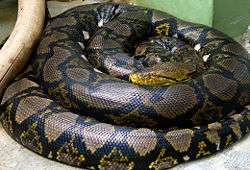 | |
| Scientific classification | |
| Kingdom: | Animalia |
| Phylum: | Chordata |
| Class: | Reptilia |
| Order: | Squamata |
| Suborder: | Serpentes |
| Family: | Pythonidae |
| Genus: | Python |
| Species: | P. reticulatus |
| Binomial name | |
| Python reticulatus | |
| Synonyms | |
Subspecies:
| |
The reticulated python (Python reticulatus)[1] is a species of python found in South Asia and Southeast Asia. They are the world's longest snakes and longest reptiles, and among the three heaviest snakes. Like all pythons, they are nonvenomous constrictors. There have been people who have been killed (and in at least two reported cases, eaten) by reticulated pythons.[7][8]
An excellent swimmer, P. reticulatus has been reported far out at sea and has colonized many small islands within its range. The specific name, reticulatus, is Latin meaning "net-like", or reticulated, and is a reference to the complex colour pattern.[9]
Description
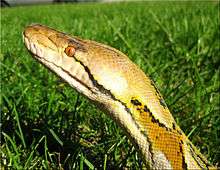
This species is the largest snake native to Asia. More than a thousand wild reticulated pythons in southern Sumatra were studied and estimated to have a length range of 1.5 to 6.5 m (4.9 to 21.3 ft) and a weight range of 1 to 75 kg (2.2 to 165.3 lb).[10] Reticulated pythons with lengths more than 6 m (19.7 ft) are rare, though according to the Guinness Book of World Records, it is the only extant snake to regularly exceed that length.[11] A reticulated python of the same length as a green anaconda may weigh only half as much as the bulkier anaconda.[11] One of the largest scientifically measured specimens, from Balikpapan, East Kalimantan, Indonesia, was measured under anesthesia at 6.95 m (22.8 ft) and weighed 59 kg (130 lb) after not having eaten for nearly 3 months.[12] Widely published data of specimens that were reported to be several feet longer have not been confirmed.
The specimen once widely accepted as the largest-ever "accurately" measured snake, that being Colossus, a specimen kept at the Highland Park Zoo (now the Pittsburgh Zoo and PPG Aquarium) in Pittsburgh, Pennsylvania, during the 1950s and early 1960s, with a peak reported length of 8.7 metres (28 ft 7 in) from a measurement in November 1956, was later shown to have been substantially shorter than previously reported. When Colossus died on April 14, 1963, its body was deposited in the Carnegie Museum of Natural History. At that time, its skeleton was measured and found to be 20 ft 10 in (6.35 m) in total length, and the length of its fresh hide was measured as 23 ft 11 in (7.29 m) – both measurements being significantly shorter than what had been previously estimated in 1956.[13] The hide tends to stretch from the skinning process, and thus be longer than the snake from which it came – e.g., by roughly 20–40% or more.[14] The previous reports had been constructed by combining partial measurements with estimations to compensate for "kinks", since it is virtually impossible to completely straighten an extremely large live python. Because of these issues, a 2012 journal article concluded that "Colossus was neither the longest snake nor the heaviest snake ever maintained in captivity." Too large to be preserved with formaldehyde and then stored in alcohol, the specimen was instead prepared as a disarticulated skeleton. The hide was sent to a laboratory to be tanned, but it was either lost or destroyed, and now only the skull and selected vertebrae and ribs remain in the museum's collection.[13] There is considerable confusion in the literature over whether Colossus was male or female (females tend to be larger).[13][14]

Numerous reports have been made of larger snakes, but since none of these was measured by a scientist nor any of the specimens deposited at a museum, they must be regarded as unproven and possibly erroneous. In spite of what has been, for many years, a standing offer of a large financial reward (initially $1,000, later raised to $5,000, then $15,000 in 1978 and $50,000 in 1980) for a live, healthy snake over 30 ft (9.1 m) long by the New York Zoological Society (later renamed as the Wildlife Conservation Society), no attempt to claim this reward has ever been made.[14]
The colour pattern is a complex geometric pattern that incorporates different colours. The back typically has a series of irregular diamond shapes flanked by smaller markings with light centers. In this species' wide geographic range, much variation of size, colour, and markings commonly occurs.

In zoo exhibits, the colour pattern may seem garish, but in a shadowy jungle environment amid fallen leaves and debris, it allows them to virtually disappear. Called disruptive colouration, it protects them from predators and helps them to catch their prey.[15]
The smooth dorsal scales are arranged in 69–79 rows at midbody. There are deep pits on four anterior upper labials, on two or three anterior lower labials, and on five or six posterior lower labials.[16]
Distribution and habitat
Reticulated pythons are found in South Asia from the Nicobar Islands, India, Bangladesh, Burma, Thailand, Laos, Cambodia, Vietnam, Malaysia, and Singapore, east through Indonesia and the Indo-Australian Archipelago (Sumatra, the Mentawai Islands, the Natuna Islands, Borneo, Sulawesi, Java, Lombok, Sumbawa, Sumba, Flores, Timor, Maluku, Tanimbar Islands) and the Philippines (Basilan, Bohol, Cebu, Leyte, Luzon, Mindanao, Mindoro, Negros, Palawan, Panay, Polillo, Samar, Tawi-Tawi). The original description does not include a type locality. Restricted to "Java" by Brongersma (1972).[2]
Three subspecies have been proposed,[17] but are not recognized in the Integrated Taxonomic Information System (ITIS). The color and size can vary a great deal among the subspecies described. Geographical location is a good key to establishing the subspecies, as each one has a distinct geographical range.
The reticulated python lives in rain forests, woodlands, and nearby grasslands. It is also associated with rivers and is found in areas with nearby streams and lakes. An excellent swimmer, it has even been reported far out at sea and has consequently colonized many small islands within its range.[15] During the early years of the 20th century, it is said to have been common even in busy parts of Bangkok, sometimes eating domestic animals.[18]
Feeding

Their natural diet includes mammals and occasionally birds. Small specimens up to 3–4 m (9.8–13.1 ft) long eat mainly rodents such as rats, whereas larger individuals switch to prey such as Viverridae (e.g. civets and binturongs), and even primates and pigs. Near human habitation, they are known to snatch stray chickens, cats, and dogs on occasion. Among the largest, fully documented prey items to have been taken are a half-starved sun bear of 23 kilograms that was eaten by a 6.95-m (22.8-ft) specimen and took some ten weeks to digest, as well as pigs of more than 60 kg (132 lb).[10] As a rule, these snakes seem able to swallow prey up to one-quarter their own length and up to their own weight.[12] As with all pythons, they are primarily ambush hunters, usually waiting until prey wanders within strike range before seizing it in their coils and killing by constriction. However, at least one case is reported of a foraging python entering a forest hut and taking a child.[19]
Danger to humans
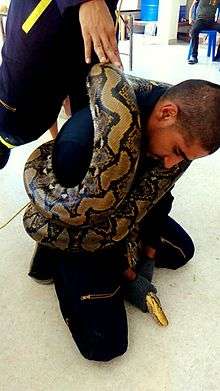
Reticulated pythons are among the few snakes that prey on humans. Attacks on humans are not common, but this species has been responsible for several reported human fatalities, in both the wild and captivity. Considering the known maximum prey size, it is possible for a full-grown reticulated python to open its jaws wide enough to swallow a human, but the width of the shoulders of some adult Homo sapiens can pose a problem for even a snake with sufficient size. Reports of human fatalities and human consumption (the latest examples of consumption of an adult human being well authenticated) include:
- In early 20th-century Indonesia: On Salibabu island, North Sulawesi, a 14-year-old boy was killed and supposedly eaten by a specimen 5.17 m (17.0 ft) in length. Another incident involved a woman reputedly eaten by a "large reticulated python", but few details are known.[20]
- Franz Werner reported a case from Burma occurring either in the early 1910s or in 1927.[14] A jeweller named Maung Chit Chine, who went hunting with his friends, was apparently eaten by a 6 m (19.7 ft) specimen after he sought shelter from a rainstorm in or under a tree. Supposedly, he was swallowed feet-first, contrary to normal snake behaviour, but perhaps the easiest way for a snake to actually swallow a human.[21]
- In 1932, Frank Buck wrote about a teenage boy who was eaten by a pet 25 ft (7.6 m) reticulated python in the Philippines. According to Buck, the python escaped, and when it was found, a human child's shape was recognized inside the snake, and turned out to be the son of the snake's owner.[22]
- Among a small group of Aeta negritos in the Philippines, six deaths by pythons were said to have been documented within a period of 40 years, plus one who died later of an infected bite.[19]
- On September 4, 1995, Ee Heng Chuan, a 29-year-old rubber tapper from the southern Malaysian state of Johor, was reported to have been killed by a large reticulated python. The victim had apparently been caught unaware and was squeezed to death. The snake had coiled around the lifeless body with the victim's head gripped in its jaws when it was stumbled upon by the victim's brother. The python, reported as measuring 23 ft (7.0 m) long and weighing more than 300 lb, was killed soon after by the arriving police, who shot it four times.[14]
- On October 23, 2008, a 25-year-old Virginia Beach, Virginia woman, Amanda Ruth Black, appeared to have been killed by a 13-foot (4.0 m) pet reticulated python. The apparent cause of death was asphyxiation. The snake was later found in the bedroom in an agitated state.[23]
- On January 21, 2009, a 3-year-old Las Vegas boy was wrapped in the coils of an 18-foot (5.5 m) pet reticulated python, turning blue. The boy's mother, who had been petsitting the python on behalf of a friend, rescued the toddler by gashing the python with a knife. The snake was later euthanized because of its wounds.[24]
- On March 27, 2017, the body of Akbar Salubiro, a 25-year-old farmer in Central Mamuju Regency, West Sulawesi, Indonesia, was found inside the stomach of a 7 m (23 ft) reticulated python. He had been declared missing from his palm tree plantation, and the people searching for him found the python the next day with a large bulge in its stomach. They killed the python and found the whole body of the missing farmer inside. This was the first fully confirmed case of a person being eaten by a python. The process of retrieving the body from the python's stomach was documented by pictures and videos taken by witnesses.[25][26][27][28]
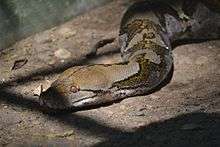 Reticulated python in Pune
Reticulated python in Pune - In June of 2018, a 54-year-old Indonesian woman, a vegetable farmer in Muna Island, Southeast Sulawesi, Indonesia, was killed and eaten by a 23-foot python. The woman went missing one night while working in her garden, and the next day a search party was organized after some of her belongings were found abandoned in the garden. The python was found near the garden with a large bulge in its body. The snake was killed and carried into town where it was cut open revealing the woman's body completely intact.[29] Video of the snake being gutted was posted online.[30][31]
Reproduction
Oviparous, females lay between 15 and 80 eggs per clutch. At an optimum incubation temperature of 31–32 °C (88–90 °F), the eggs take an average of 88 days to hatch.[32] Hatchlings are at least 2 ft (61 cm) in length.[18]
Captivity
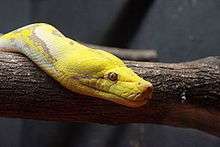
Increased popularity in the pet trade is due largely to increased efforts in captive breeding and selectively bred mutations such as the "albino" and "tiger" strains. They can make good captives, but keepers should have previous experience with such large constrictors to ensure safety to both animal and keeper. Although their interactivity and beauty draws much attention, some feel they are unpredictable.[33][34] They do not attack humans by nature, but will bite and possibly constrict if they feel threatened, or mistake a hand for food. While not venomous, large pythons can inflict serious injuries, sometimes requiring stitches.

The huge size and attractive pattern of these snakes has made them favorite zoo exhibits, with several individuals claimed to be above 20 ft (6.1 m) in length and more than one claimed to be the largest in captivity.[35][36][37][38] However, due to their huge size, immense strength, aggressive disposition, and the mobility of the skin relative to the body, it is very difficult to get exact length measurements on a living reticulated python, and weights are rarely indicative, as captive pythons are often obese.[14] Claims made by zoos and animal parks are sometimes exaggerated, such as the claimed 14.85 m (48.7 ft) snake in Indonesia which was subsequently proven to be about 6.5 m (21.3 ft) long.[39][40] For this reason, scientists do not accept the validity of length measurements unless performed on a dead or anesthetized snake which is later preserved in a museum collection or stored for scientific research.[14]
Also, dwarf forms of reticulated pythons occur, from some islands that are northwest of Australia, and these are being selectively bred in captivity to be much smaller, resulting in animals often referred to as "super dwarfs". Adult super dwarf reticulated pythons are typically between 1.82 m (6 ft) and 2.4 m (8 ft) in length[41].
Taxonomy

Three subspecies may be encountered, including two new ones:
- P. r. reticulatus (Schneider, 1801) – Called "retics" in herpetoculture.
- P. r. jampeanus Auliya et al., 2002 – Kayaudi dwarf reticulated pythons or Jampea retics, about half the length,[32] or according to Auliya et al. (2002), not reaching much more than 2 m (6.6 ft) in length.[17] Found on Tanahjampea in the Selayar Archipelago south of Sulawesi. Closely related to P. r. reticulatus of the Lesser Sundas.[17]
- P. r. saputrai Auliya et al., 2002 – Selayer reticulated pythons or Selayer retics. Found on Selayar Island in the Selayar Archipelago and also adjacent Sulawesi. This subspecies represents a sister lineage to all other populations of reticulated pythons tested.[17] According to Auliya et al. (2002) it does not exceed 4 m (13.1 ft) in length.[17]
The latter two are dwarf subspecies. Apparently, the population of the Sangihe Islands north of Sulawesi represents another such subspecies which is basal to the P. r. reticulatus plus P. r. jampeanus clade, but it is not yet formally described.[17]
The proposed subspecies "dalegibbonsi", "euanedwardsi", "haydnmacphiei", "neilsonnemani", "patrickcouperi", and "stuartbigmorei"[3][42] have not found general acceptance.
A phylogenetic study of pythons has suggested that the reticulated python as well as the Timor python are more closely related to Australasian pythons, suggesting that they are an intermediate form between the Australasian pythons and the Afro-Asian genus Python, and should therefore be placed in a separate genus.[43] The genus name Broghammerus was proposed by Raymond Hoser in 2003/2004.[3][4] However, this and a numerous other names by the same author were criticized by Kaiser et al. (2013),[44] who proposed ignoring them for the purposes of nomenclature. Reynolds et al. subsequently described the genus Malayopython for this species and its sister species, the Timor python, calling the Timor python M. timoriensis.[5] Hoser has since said that the Malayopython name is a junior synonym of Broghammerus and thus should not be recognized by the International Code of Zoological Nomenclature.[45] Neither of these proposed reclassifications has been recognized by the ITIS,[1] but Malayopython has been recognized by a number of subsequent authors[46][47] and the Reptile Database.
See also
- List of largest snakes
- Burmese python
- List of pythonid species and subspecies
- Pythonidae by common name
- Pythonidae by taxonomic synonyms
References
- 1 2 3 "Python reticulatus". Integrated Taxonomic Information System. Retrieved 12 September 2007.
- 1 2 McDiarmid RW, Campbell JA, Touré TA (1999). Snake Species of the World: A Taxonomic and Geographic Reference, Volume 1. Washington, District of Columbia: Herpetologists' League. 511 pp. ISBN 1-893777-00-6 (series). ISBN 1-893777-01-4 (volume).
- 1 2 3 Hoser, Raymond (2003). "HTML A Reclassification of the Pythoninae Including the Descriptions of Two New Genera, Two New Species, and Nine New Subspecies. Part I". Crocodilian. 4 (3): 31–37.
- 1 2 http://www.smuggled.com/issue-16-19-26.pdf
- 1 2 Reynolds RG, Niemiller ML, Revell LJ (2014). "Toward a tree-of-life for the boas and pythons: multilocus species-level phylogeny with unprecedented taxon sampling". Molecular Phylogenetics and Evolution. 71: 201–213. doi:10.1016/j.ympev.2013.11.011. PMID 24315866.
- ↑ "Malayopython reticulatus ". The Reptile Database. http://reptile-database.reptarium.cz/species?genus=Malayopython&species=reticulatus
- ↑ "Actual footage of dissecting a man-eater reticulated python in Mamuju, Sulawesi, Indonesia". Youtube.
- ↑ Selk, Avi. "A woman went to check her corn — and was swallowed by a python". The Washington Post. Retrieved 17 June 2018.
- ↑ Gotch AF (1986). Reptiles – Their Latin Names Explained. Poole, UK: Blandford Press. ISBN 0-7137-1704-1.
- 1 2 Shine R, Harlow PS, Keogh JS, Boeadi NI (1998). "The influence of sex and body size on food habits of a giant tropical snake, Python reticulatus ". Functional Ecology. 12 (2): 248–258. doi:10.1046/j.1365-2435.1998.00179.x.
- 1 2 Wood, Gerald (1983). The Guinness Book of Animal Facts and Feats. ISBN 978-0-85112-235-9.
- 1 2 Fredriksson, Gabriella M. (2005). "Predation on Sun Bears by Reticulated Python in East Kalimantan, Indonesian Borneo" (PDF). Raffles Bulletin of Zoology. 53 (1): 165–168. Archived from the original (PDF) on 2007-08-11.
- 1 2 3 Barker, David G.; Barten, Stephen L.; Ehrsam, Jonas P.; Daddono, Louis (2012). "The Corrected Lengths of Two Well-known Giant Pythons and the Establishment of a new Maximum Length Record for Burmese Pythons, Python bivittatus " (PDF). Bull. Chicago Herp. Soc. 47 (1): 1–6.
- 1 2 3 4 5 6 7 Murphy, John C.; Henderson, Robert W. (1997). Tales of Giant Snakes: A Historical Natural History of Anacondas and Pythons. Krieger Publishing Co. pp. 24–26, 35, 47–50, 55–56. ISBN 0-89464-995-7.
- 1 2 Mehrtens JM (1987). Living Snakes of the World in Color. New York: Sterling Publishers. 480 pp. ISBN 0-8069-6460-X.
- ↑ Boulenger GA (1893). Catalogue of the Snakes in the British Museum (Natural History). Volume I., Containing the Families ... Boidæ ... London: Trustees of the British Museum (Natural History). (Taylor and Francis, Printers). xiii + 448 pp. + Plates I-XXVIII. (Python reticulatus, pp. 85-86).
- 1 2 3 4 5 6 Auliya, M.; Mausfeld, P.; Schmitz, A.; Böhme, W. (2002-04-09). "Review of the reticulated python (Python reticulatus Schneider, 1801) with the description of new subspecies from Indonesia". Naturwissenschaften. 89 (5): 201–213. doi:10.1007/s00114-002-0320-4. Retrieved 2012-04-08.
- 1 2 Stidworthy J (1974). Snakes of the World. Grosset & Dunlap Inc. 160 pp. ISBN 0-448-11856-4.
- 1 2 Headland TN, Greene HW (2011). "Hunter–gatherers and other primates as prey, predators, and competitors of snakes". Proceedings of the National Academy of Sciences. 108 (52): E1470. doi:10.1073/pnas.1115116108. PMC 3248510. PMID 22160702.
- ↑ Kopstein F (1927). "Over het verslinden van menschen door Python reticulatus [On the swallowing of humans by P. reticulatus]". Tropische Natuur 4: 65–67. (in Dutch).
- ↑ Bruno, Silvio (1998). "I serpenti giganti [The giant snakes]". Criptozoologia 4: 16–29. (in Italian).
- ↑ Kobis I (1995). "Giant python killed after trying to swallow man". The Star (Malaysian English newspaper), 16 September 1995.
- ↑ "Woman killed by pet 13-foot python" at UPI. Accessed 27 October 2008.
- ↑ "In Las Vegas, python vs. angry mom with a knife" at Las Vegas Sun. Accessed 23 January 2009.
- ↑ Nurhadi (28 March 2017). "Beginilah Ular Piton Menelan Akbar Petani Sawit Memuju Tengah ". Tribun Timur (in Indonesian). Retrieved 28 March 2017.
- ↑ Collins D (28 March 2017). "Gruesome moment dead man's corpse is cut out of the stomach of a massive python in Indonesia". The Sun. Retrieved 28 March 2017.
- ↑ "Missing man found dead in belly of 7m-long python in Indonesia: Report". Straits Times. 29 March 2017. Retrieved 2017-03-29.
- ↑ "Indonesian man's body found inside python – police". BBC. 2017-03-29. Retrieved 2017-03-29.
- ↑ Press, Associated. "23-foot python swallows Indonesian woman near her garden". latimes.com. Retrieved 2018-06-17.
- ↑ Ular Sanca makan manu sia di sulawesi tenggara, retrieved 2018-06-17
- ↑ Video Viral Wanita Ditelan Ular Piton Raksasa di Sultra, retrieved 2018-06-17
- 1 2 Mattison, Christopher (1999). Snake. London: Dorling Kindersley Publishing (DK). ISBN 0-7894-4660-X.
- ↑ "Reticulated Python Care (Python reticulatus) – Eco Terrarium Supply". Retrieved 2009-02-06.
- ↑ "Reticulated Pythons - Boatips.com". Retrieved 2009-02-06.
- ↑ "Columbus Zoo Pays to Keep Largest Snake in Captivity on Permanent Display". Fox News. 14 January 2008.
- ↑ "22-Foot Python In Fla. Is World's Largest". Orlando News (2008-01-24)
- ↑ Rimba Reptil ( Rimba Reptile Park ). Marriott.com. Retrieved on 2012-08-21.
- ↑ "Never Leather, Samantha The Python Dies at the Zoo". New York Times (2002-11-22). Retrieved on 2012-08-21.
- ↑ "World's 'longest snake' comes up short". China Daily.
- ↑ Aglionby, John (2004-01-05) "Stay still, will you?". Guardian. Retrieved on 2012-08-21.
- ↑ "Reticulated Python Care Sheet". www.reptilesmagazine.com. Retrieved 2018-07-07.
- ↑ Hoser, Raymond (2004). "A Reclassification of the Pythoninae Including the Descriptions of Two New Genera, Two New Species, and Nine New Subspecies. Part II". Crocodilian. 4 (4): 21–40.
- ↑ Rawlings LH, Rabosky DL, Donnellan SC, Hutchinson MN (2008). "Python phylogenetics: inference from morphology and mitochondrial DNA". Biological Journal of the Linnean Society. 93 (3): 603. doi:10.1111/j.1095-8312.2007.00904.x.
- ↑ Kaiser H, Crother BI, Kelly CMR, Luiselli L, O'Shea M, Ota H, Passos P, Schleip W, Wüster W (2013). "Best Practices: In the 21st Century, Taxonomic Decisions in Herpetology are Acceptable Only When Supported by a Body of Evidence and Published via Peer-Review" (PDF). Herpetological Review. 44 (1): 8–23.
- ↑ http://www.smuggled.com/issue-25-pages-14-38.pdf
- ↑ Barker DG, Barker TM, David MA, Schuett GW (2015). "A review of the systematics and taxonomy of Pythonidae: an ancient serpent lineage" (PDF). Zoological Journal of the Linnean Society. 175: 1–19. doi:10.1111/zoj.12267.
- ↑ Booth W, Schuett GW (2016). "The emerging phylogenetic pattern of parthenogenesis in snakes". Biological Journal of the Linnean Society. 118: 172–186. doi:10.1111/bij.12744.
Further reading
- Auliya MA (2003). Taxonomy, Life History and Conservation of Giant Reptiles in West Kalimantan. Ph.D. thesis, University of Bonn.
- Auliya MA, Mausfeld P, Schmitz A, Böhme W (2002). "Review of the reticulated python (Python reticulatus Schneider, 1801 [sic]) with the description of new subspecies from Indonesia". Naturwissenschaften 89 (5): 201–213. doi:10.1007/s00114-002-0320-4 (HTML abstract, electronic supplement available to subscribers).
- Raven HC (1946). "Adventures in python country". Natural History. 55: 38–41.
- Schneider JG (1801). Historiae Amphibiorum naturalis et literariae Fasciculus Secundus continens Crocodilos, Scincos, Chamaesauras, Boas, Pseudoboas, Elapes, Angues, Amphisbaenas et Caecilias. Jena: Frommann. vi + 364 pp. + 2 plates. ("[Boa] Reticulata", new species, pp. 264–266). (in Latin).
- Shine R, Ambariyanto, Harlow PS, Mumpuni (1999). "Reticulated pythons in Sumatra: biology, harvesting and sustainability". Biol. conserv. 87 (3): 349-357. ISSN 0006-3207. Abstract at CAT.INIST. Accessed 12 September 2007.
External links
| Wikimedia Commons has media related to Python reticulatus. |
- Reticulated python life history at Reticulatedpython.info . Accessed 7 November 2009
- Python reticulatus at ReptileExpert.org. Accessed 22 August 2011.
- Reticulated python at Answers.com. Accessed 12 September 2007.
- Study of man-eating snakes: Snakes are predators on, prey of, and competitors with primates Cornell Chronicle Online. Accessed 22 December 2011.
- 25 ft World's Longest Snake
- Python swallows Indonesian man whole Fox News